Are you dreaming of starting an Amazon business, but feel overwhelmed by the thought of where to even begin?
We get it.
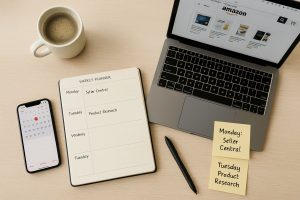 When we first started over a decade ago, we were working full-time jobs and trying to figure out how to launch a side hustle that wouldn’t take over our lives. Fast forward to today, we’ve sold and managed over $40 million on Amazon and taught thousands of people how to do the same.
When we first started over a decade ago, we were working full-time jobs and trying to figure out how to launch a side hustle that wouldn’t take over our lives. Fast forward to today, we’ve sold and managed over $40 million on Amazon and taught thousands of people how to do the same.
The truth is: you don’t need to quit your job, have endless free time, or be a tech wizard to build a successful Amazon business. You just need a smart plan and the discipline to stick to it.
This post will show you how to:
- Manage your time effectively as you get started.
- Use simple tools to save hours each week.
- Balance your new business with your current job and life.
- Follow a weekly planner designed for beginners.
Let’s dive right in!
Why Time Management Matters When You’re Starting Out
Many people never start selling because they’re afraid they don’t have enough time. Between work, family, and everything else, it can feel impossible.
Here’s the good news: you don’t need 40 hours a week. With as little as 30-60 minutes a day, you can start laying the foundation for your Amazon business.
We’ll show you how to focus on the right steps in the right order.
The 4 Core Steps to Get Started (and How to Prioritize)
When you’re new, there are four major tasks to learn and practice:
- Learning Seller Central
- This is Amazon’s dashboard for sellers. Get familiar with it now so it’s not intimidating later.
- Solution: Watch beginner tutorials for 15 minutes a day and explore the features.
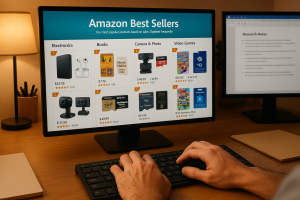 Researching Products
Researching Products- Start identifying products that could sell well. Don’t overthink it; this is about practice.
- Solution: Dedicate short blocks of time twice a week to look at Amazon’s bestseller lists and note interesting items.
- Reaching Out to Brands
- Building supplier relationships is key. You can start by learning how to craft simple, professional emails.
- Solution: Write draft outreach emails now so you’re ready when you’re approved to sell.
- Scouting Leads
- Once you understand the basics, spend time finding potential wholesale suppliers and products.
- Solution: Block an hour on the weekend for research when you’re fresh.
A Simple Weekly Planner for Beginners
Here’s a sample schedule to help you build momentum without burning out:
Monday
- Evening (30 min): Explore Seller Central and watch a beginner tutorial.
Tuesday
- Evening (30 min): Research 2-3 potential products.
Wednesday
- Evening (30 min): Draft practice outreach emails to brands.
 Thursday
Thursday
- Evening (30 min): Read an Amazon success story or case study for inspiration.
Friday
- Evening (30 min): Review your progress and set simple goals for next week.
Saturday/Sunday
- Block 1-2 hours for scouting suppliers or watching workshop videos.
Remember: consistency matters more than intensity.
Simple Tools to Save You Time
Here are a few beginner-friendly tools that can save you hours:
- Task List Apps: Use free tools like Todoist to track your action steps.
- Calendar Blocks: Schedule Amazon work sessions on your calendar to stay accountable.
- Learning Platforms: Bookmark free Amazon resources or sign up for our workshop to avoid getting lost in YouTube rabbit holes.
How to Balance Your New Business With Life
Starting something new takes effort, but it shouldn’t consume you.
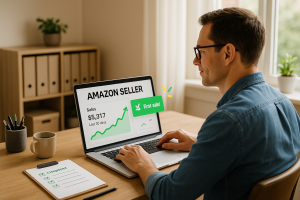 Set Realistic Expectations: Start with small daily goals instead of aiming for perfection.
Set Realistic Expectations: Start with small daily goals instead of aiming for perfection.- Block Focused Time: Even 30 focused minutes beats 2 distracted hours.
- Communicate With Family: Let them know you’re dedicating time to building a future income stream.
- Celebrate Small Wins: Every step forward is progress.
You Don’t Have to Be Perfect to Start
We didn’t know everything when we started. We made mistakes, learned from them, and kept going.
What matters most is that you start.
- Watch tutorials.
- Explore Seller Central.
- Research your first few products.
Bit by bit, you’ll build confidence and momentum.
You can do this.
Quick Recap: Beginner’s Checklist for Amazon Success
- ✅ Spend 30 minutes a day learning and researching.
- ✅ Explore Seller Central and get comfortable.
- ✅ Draft sample outreach emails to practice.
- ✅ Block time on your calendar to stay consistent.
- ✅ Use simple tools to stay organized.
- ✅ Keep your work-life balance intact.
- ✅ Join our free workshop for step-by-step guidance.
Remember, you don’t need to have it all figured out to take the first step. Just start taking small actions each day.

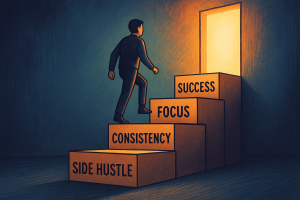 Yet, with as little as an hour a day, they’ve built thriving ecommerce businesses that have changed their lives. Together, we’ve managed over $40 million in Amazon revenue using systems that work, even if you’re strapped for time.
Yet, with as little as an hour a day, they’ve built thriving ecommerce businesses that have changed their lives. Together, we’ve managed over $40 million in Amazon revenue using systems that work, even if you’re strapped for time.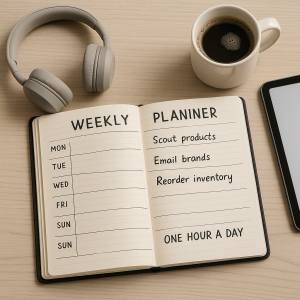 Right before Christmas one year, he unexpectedly lost his job. With a baby daughter at home and his wife staying home to care for her, he felt a wave of fear and uncertainty.
Right before Christmas one year, he unexpectedly lost his job. With a baby daughter at home and his wife staying home to care for her, he felt a wave of fear and uncertainty.  Day 1: Scouting Products (60 min)
Day 1: Scouting Products (60 min) Day 4: Maintaining Your Seller Account (60 min)
Day 4: Maintaining Your Seller Account (60 min)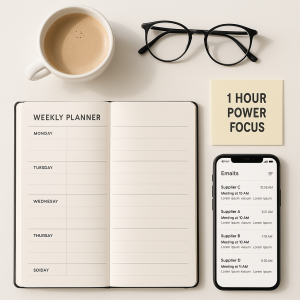 Here’s what a full week could look like for someone growing their business part time:
Here’s what a full week could look like for someone growing their business part time: Here is one way to break it down:
Here is one way to break it down: Avoid listings where Amazon is a seller more than 25% of the time
Avoid listings where Amazon is a seller more than 25% of the time
 That’s where free task and workflow tools come in.
That’s where free task and workflow tools come in. Just start by handing off the
Just start by handing off the 
 For most new sellers, this is the point where excitement turns to overwhelm. That first “yes” is everything—but it comes with responsibilities. You’re not just buying inventory; you’re becoming a trusted partner. And how you handle the next steps can determine whether that brand works with you long-term or walks away.
For most new sellers, this is the point where excitement turns to overwhelm. That first “yes” is everything—but it comes with responsibilities. You’re not just buying inventory; you’re becoming a trusted partner. And how you handle the next steps can determine whether that brand works with you long-term or walks away. This is where a
This is where a  Keep an eye out for:
Keep an eye out for: Why 5 Products?
Why 5 Products? Common Mistakes (And How to Avoid Them)
Common Mistakes (And How to Avoid Them)